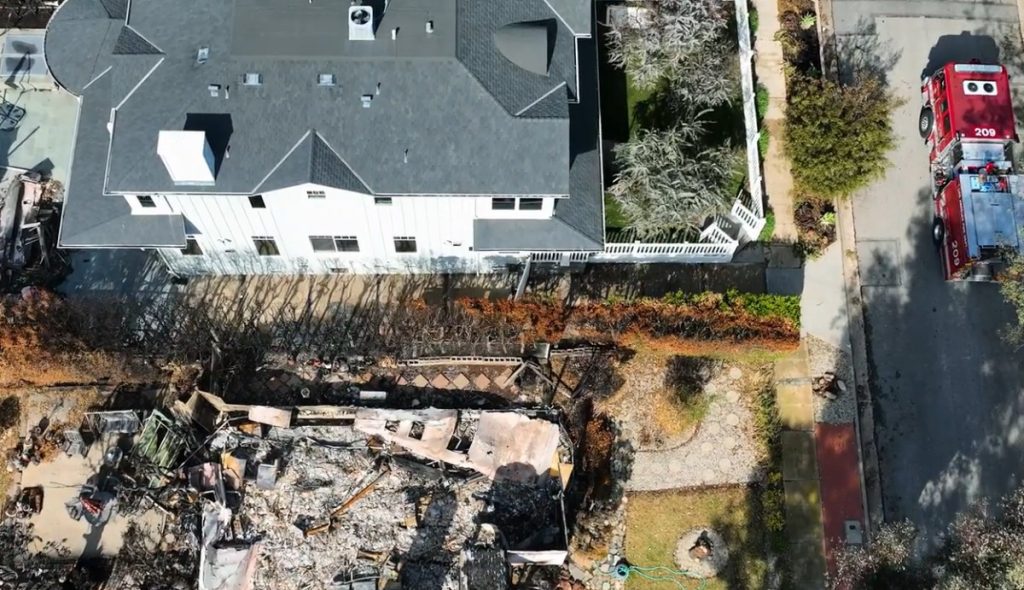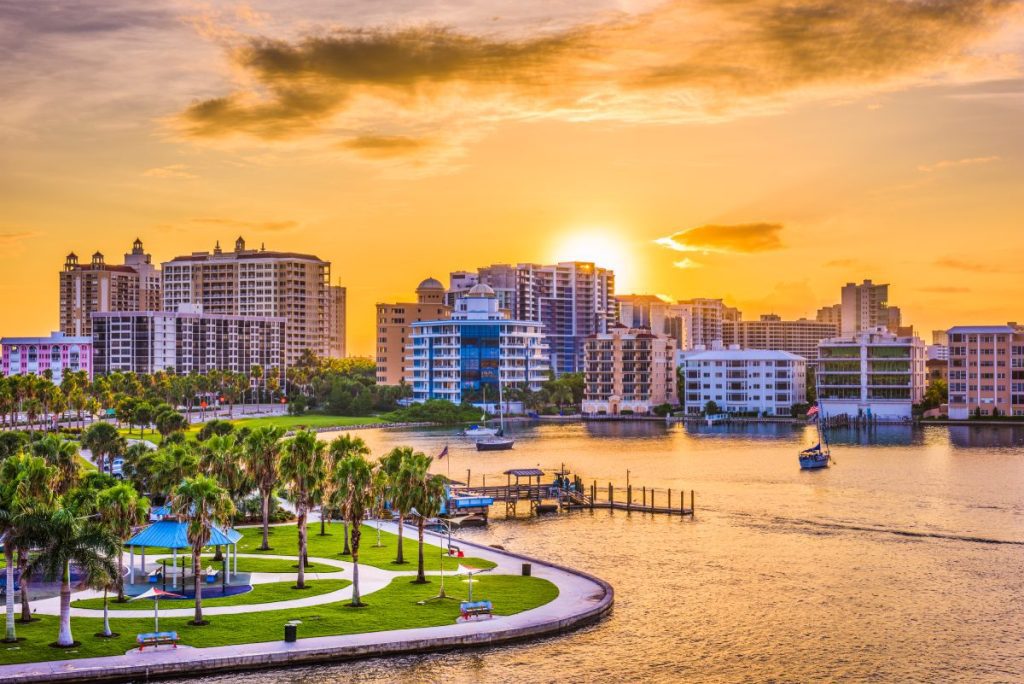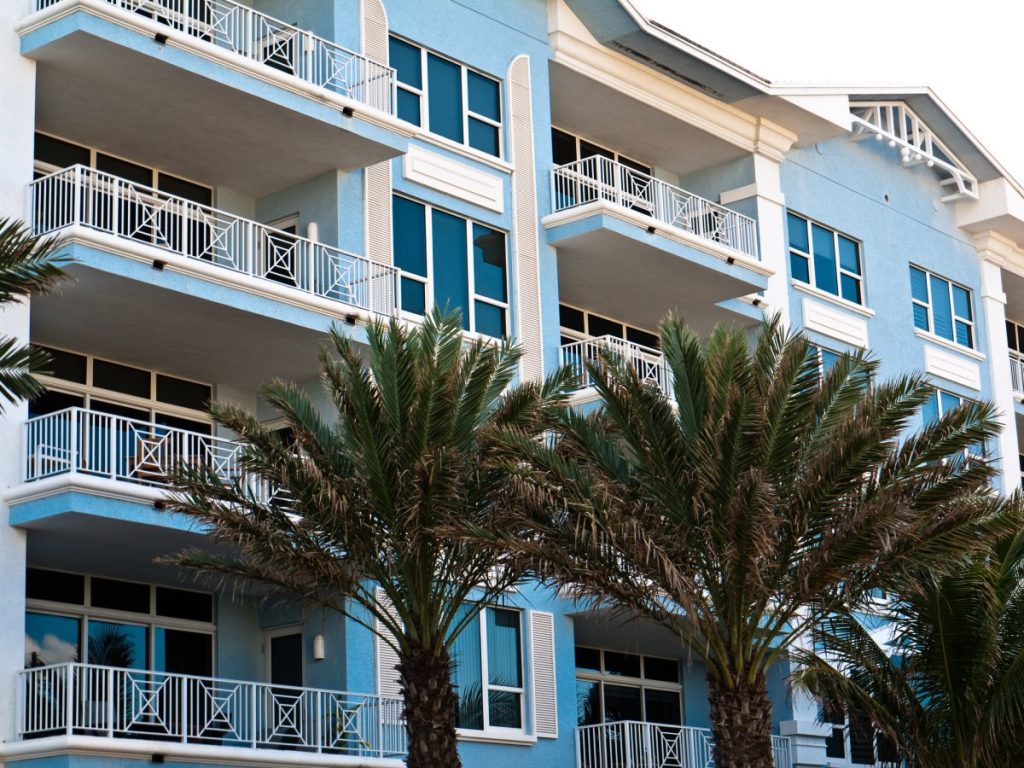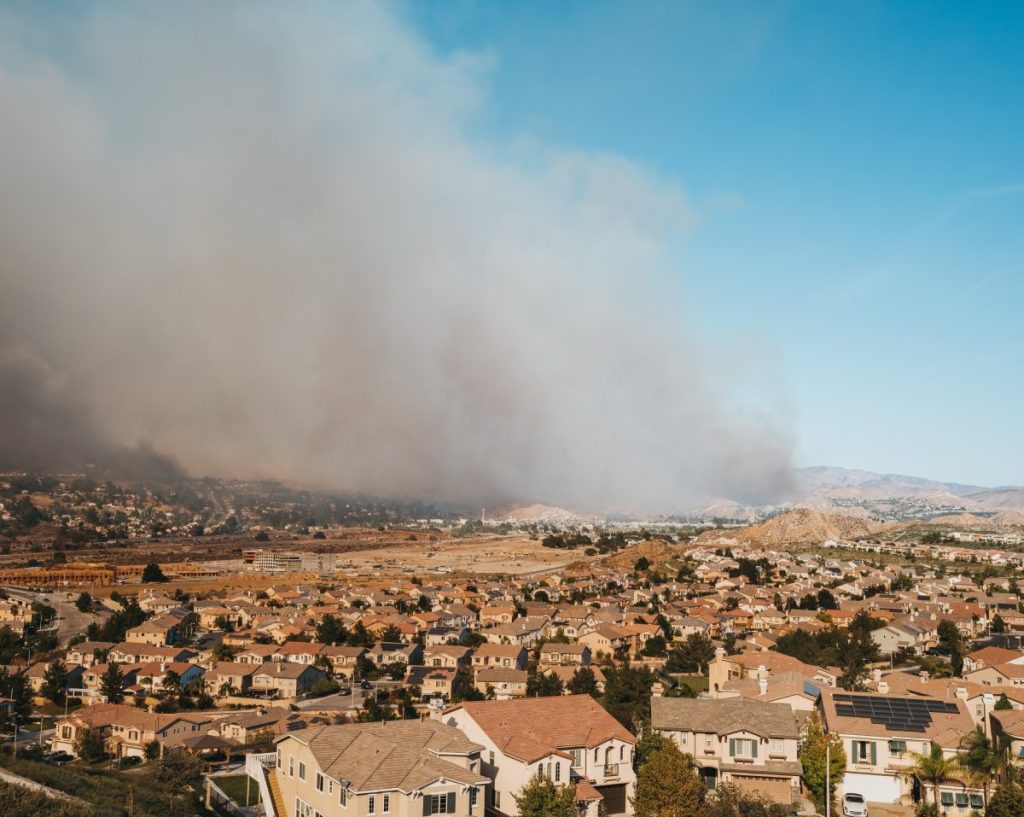California’s wildfire seasons are growing longer, hotter, and more destructive with each passing year. While the headlines often focus on dramatic images of homes reduced to ash, the truth is that many property owners suffer serious losses even when the flames stop short of their doorstep. Smoke infiltration, toxic soot, prolonged power outages, and forced evacuations can all leave behind costly damage and lingering questions about what your insurance policy actually covers.
Even if your home or business wasn’t physically destroyed by fire, you might still have a valid wildfire insurance claim. The indirect impact of wildfires—such as smoke contamination, business interruption, additional living expenses incurred by the need to evacuate, and the costs of cleaning and repair—can all trigger coverage under many fire insurance policies in California.
This blog explains what Californians need to know about these often-overlooked claims. We’ll help you understand your rights under your policy, identify the types of damages that may be compensable, and offer guidance on how to navigate the claims process successfully.
At Merlin Law Group, we’ve spent decades fighting for policyholders who are met with resistance, delays, or denials from their insurers in the wake of disasters like the Palisades Fire. We’re here to make sure you get the coverage you paid for and the recovery you deserve.
Can You File a Wildfire Claim Without Structural Damage?
One of the most common misconceptions about wildfire insurance claims is that you need to lose your entire home or building to file one. In reality, many home insurance policies cover a broad range of indirect losses that occur even when the structure itself remains intact. If your home or business was surrounded by flames, filled with smoke, or temporarily uninhabitable due to evacuation orders, you may be entitled to compensation from your property insurance.
For example, smoke contamination can make a home unsafe to live in, even if the walls are still standing. Fine particulates and toxic residues can seep into the walls, the carpets, the HVAC systems, and even into personal belongings—requiring extensive cleaning, repairs, or replacement. Similarly, if you were forced to evacuate and incurred hotel bills, dining expenses, or other temporary living costs, your policy’s Additional Living Expenses (ALE) coverage may apply.
Commercial property owners may also face significant financial setbacks, from business interruption losses or from property devaluation even if their physical buildings were spared. These are all valid components of a fire insurance claim in California, and understanding them is your first step toward a full recovery.
Understanding Wildfire Insurance Coverage
Many property owners assume their home insurance will be there when disaster strikes. But in wildfire-prone California, coverage isn’t always as straightforward as it seems.
While the majority of modern homeowners insurance policies include fire damage as a standard peril, older or bare-bones policies may offer limited protections that fall short of the realities of today’s wildfires. Many of these older policies weren’t designed to reflect the increased frequency, severity, and unpredictability accounted for in new policies. They may use narrow definitions of “fire damage” that may not clearly extend to secondary effects like heat warping, HVAC contamination, or preventative actions taken before a fire reaches the property. Or they may base their dwelling coverage or replacement cost on assessments made years ago without accounting for the true cost of rebuilding in today’s economy, especially for custom or luxury properties. That gap can leave policyholders severely underinsured.
Homeowners Insurance vs. Standalone Fire Insurance
It’s also important to distinguish between homeowners insurance and standalone fire insurance. A comprehensive homeowners policy typically includes fire coverage alongside protection for theft, liability, and weather-related damage. In contrast, a fire insurance policy is usually more narrowly focused, covering losses from fire, smoke, and sometimes explosions, but not much else. This distinction matters, especially for California homeowners in zones with high wildfire risk who may have been dropped by traditional insurers and forced to cobble together coverage from multiple sources.
That’s where the California FAIR Plan comes in. Designed as a last-resort option for those who can’t obtain fire coverage in the private insurance market, a FAIR Plan policy offers limited but essential protection against fire and smoke damage. However, it does not include liability, water damage, or Additional Living Expenses (ALE), which means most homeowners still need a wraparound policy to fill in the gaps.
Regardless of how your policy is structured, many include coverage for:
- Structural damage repair
- Personal property losses
- ALE, such as hotel stays and meals
- Smoke and soot damage remediation
But remember: just because something is covered doesn’t mean your insurer will pay without a fight. Understanding your policy’s scope—and its limitations—is critical before and after a wildfire strikes.
Scenarios That Justify Claims Even Without Flames
You don’t need to see flames licking at your doorstep to experience real, claim-worthy wildfire damage. In fact, many of the most costly and disruptive wildfire losses occur in homes and businesses that never caught fire at all. Here are some examples.
Smoke Damage
Wildfire smoke is more than a nuisance—it’s a toxic mix of fine particles and chemicals that can infiltrate even the most well-sealed structures. Once it’s inside your property, smoke can:
- Ruin insulation
- Stain walls and ceilings
- Contaminate HVAC systems
- Corrode electronics
- Embed persistent odors in carpets and upholstery
These hidden hazards often require professional remediation and replacement—costs that may be covered under your wildfire insurance claim.
Loss of Use
If an evacuation order forced you to leave your home or business, your policy may provide ALE coverage. This can reimburse you for hotel stays, meals, laundry services, pet boarding, and other temporary relocation expenses. Even if your property wasn’t physically damaged, loss of use alone can justify a claim if your policy includes ALE provisions.
Preventative Measures
In some cases, expenses incurred to protect your property from fire risk before a blaze reaches it may also be reimbursable. Think sandbagging, installing fire-retardant coverings, clearing brush, or paying for temporary fire barriers. While not all policies explicitly cover preventative actions, many do—especially when those actions are recommended by authorities or align with best practices for wildfire mitigation.
Why Would an Insurance Company Deny a Wildfire Claim?
Even in the wake of a devastating wildfire, insurance providers don’t always honor claims as expected. Denials can come down to technicalities, policy fine print, or simply a disagreement over the facts. Understanding the most common reasons for denial can help you protect yourself and fight back if your claim is unfairly rejected.
Policy Exclusions
Every insurance policy has limitations, and wildfire-related losses often fall into gray areas. Some home insurance policies may exclude “gradual” damage, arguing that smoke or soot aren’t causes of sudden, accidental harm. Others may have high-value exclusions that limit compensation for luxury items, rare collectibles, or high-end systems without special endorsements. These exclusions are often buried deep in the language of your policy, but insurers rely on them to avoid full payouts.
Underinsurance
Many California property owners discover too late that their coverage limits don’t reflect the true cost of rebuilding or replacing their homes and contents. Together, rising construction costs, inflation, and outdated property valuations may mean you’re severely underinsured. When this happens, insurers may deny parts of your claim or pay only a fraction of your losses—even if the damage is clearly covered.
Failure to Mitigate
Insurers often look for ways to shift blame back onto the policyholder. One common tactic is to claim that the homeowner failed to mitigate damages. For example, if you didn’t clear brush around the home, secure windows, or protect your property after an evacuation order, your insurer may claim that your lack of action worsened the loss. Policyholders have a duty to safeguard their property against fire hazards when reasonably possible, but this doesn’t give insurers a blank check to deny valid claims.
Disputes Over Damage
Smoke contamination, fine ash, and microscopic particles can be invisible or hard to trace, and insurers may argue that the damage predated the fire or came from another source. These disputes often hinge on expert assessments, testing reports, and documentation. Without skilled advocacy, policyholders can be left footing the bill for losses that are, in fact, covered.
What To Do If a Claim Is Denied
Don’t get discouraged if your claim is initially denied. You have options—and the law is often on your side. Here’s how to fight back:
- Start With Documentation: Document the condition of your property before and after the wildfire as thoroughly as possible—photos, videos, receipts, estimates, expert reports. If your claim was denied, request a written explanation from your insurer detailing the specific policy language and rationale behind the decision. Don’t rely on vague statements or verbal conversations: demand transparency.
- Clarify Your Policy Terms: Insurance policies are notoriously difficult to read, but it’s crucial to understand the exact terms of your coverage. What perils are listed? Are smoke and soot explicitly mentioned? What are the exclusions and limits? If the language is ambiguous—and it often is—you may already have legal grounds to contest the denial. In California, courts typically interpret unclear insurance language in favor of the policyholder.
- Get Legal Help Early: Wildfire claims are complex, and insurers are highly motivated to minimize payouts. That’s why it’s wise to speak with an experienced insurance attorney as early as possible. At Merlin Law Group, we specialize in holding the insurance industry accountable when they delay, deny, or underpay valid claims. We know their playbook—and we know how to fight back.
- Consider Alternative Dispute Resolution: You don’t necessarily have to file a lawsuit to get justice. Depending on your situation, you may be able to resolve the dispute through mediation, appraisal, or binding arbitration. You can also file a formal complaint with the California Department of Insurance, which investigates unfair claims practices and may pressure your insurer to reconsider.
A denied claim isn’t a final verdict—it’s an opening move. With the right support and strategy, you can still recover what you’re owed and protect your investment.
The Role of the California Department of Insurance
The California Department of Insurance (CDI), led by current Insurance Commissioner Ricardo Lara, is tasked with regulating insurers and defending the rights of policyholders across the state. In recent years, the CDI has taken an increasingly proactive role in responding to the state’s growing wildfire crisis. Commissioner Lara has launched efforts to strengthen consumer protections, including requiring insurers to be more transparent about coverage limits, enforcing grace periods for premium payments after declared disasters, and pushing for broader access to affordable coverage in high-risk areas.
Most importantly for someone in the middle of a claim dispute, the CDI offers direct support for policyholders. If your claim is denied, delayed, or underpaid, you can file a complaint with the CDI. The department investigates unfair claims handling, reviews whether insurers are complying with policy terms and state regulations, and may even intervene to facilitate resolution.
While the CDI doesn’t offer legal representation, its oversight can put meaningful pressure on insurers and prompt a second look at your case. It’s a powerful ally—especially when combined with legal advocacy from a firm like Merlin Law Group, which regularly works alongside regulatory bodies to protect clients’ rights.
Is Your Coverage Adequate for the Next Wildfire?
Wildfire season in California is no longer confined to a few dry months—it’s a year-round threat. With climate change accelerating fire behavior and property values continuing to climb, it’s essential for California residents to review their insurance coverage annually to make sure you’re properly insured.
Inflation has left many homeowners and commercial property owners underinsured without realizing it. You could face devastating out-of-pocket expenses if your coverage limits are based on outdated valuations. Talk to your insurance broker or insurance agent to ensure your policy reflects current market conditions. Ask detailed questions: Does your policy include smoke and ash damage? Are ALE capped? What are your responsibilities during an evacuation? Complex policies can be confusing, but a knowledgeable advisor can help clarify what’s covered—and what’s missing.
Call Merlin
Insurance carriers are skilled at finding ways to delay, underpay, or deny claims. That’s why it’s essential to know your rights and be prepared to challenge their conclusions, especially when the damage is real, but not obvious, like in some fire and smoke claims.
If your property feels less livable, less functional, or less safe after a wildfire—even without burn marks on the walls—there’s a strong chance you’re entitled to compensation. At Merlin Law Group, we specialize in holding insurance companies accountable. We know how to read between the lines of a denial letter—and how to get our clients the full value of their claims.




